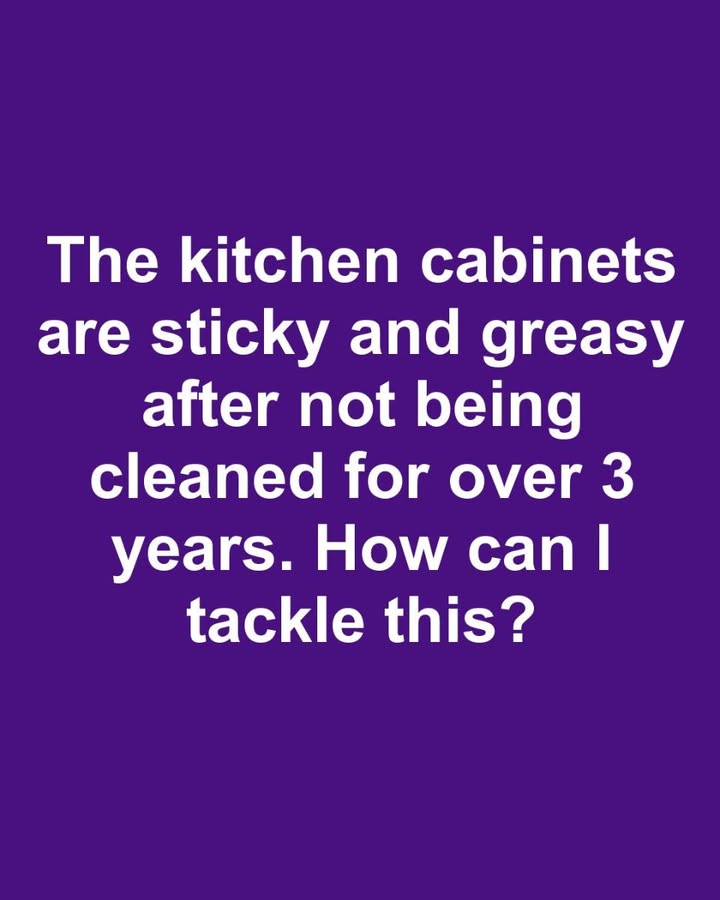The kitchen is often called the heart of the home, where delicious meals are prepared and memories are made. But over time, especially after years of cooking, your cabinets can quietly collect a sticky layer of grease and dust. This buildup doesn’t just make them look dull—it can also attract more dirt and grime. If your cabinets haven’t had a deep cleaning in over three years, now’s the perfect time to roll up your sleeves and restore their original shine.

Why Cabinets Get Sticky and Greasy
Every time you cook, tiny particles of fat, oil, and steam rise into the air. These particles eventually settle on nearby surfaces, mixing with dust and other airborne debris. Over time, they form a stubborn film that regular light cleaning can’t remove. When cabinets aren’t wiped down regularly, this layer hardens, making it much harder to clean and leaving your kitchen looking and feeling less fresh.
What You’ll Need to Get Started
A successful deep-clean begins with having the right supplies on hand. Gather the following:
-
Mild dish soap or a gentle degreaser
-
White vinegar
-
Baking soda
-
Warm water
-
Microfiber cloths
-
Sponges
-
A soft-bristle brush
-
Optional: cleaning gloves for protection
For tougher jobs, keep a natural or commercial degreasing product nearby so you can tackle the worst spots.
Prep Your Space Before Cleaning
To make the process easier and more effective, start by emptying your cabinets completely so you have clear access to all surfaces. If possible, remove handles and knobs for a more thorough clean. Cover your countertops and floors to protect them from drips, and open your windows to keep the air fresh—especially if you’re using stronger cleaning products. Having everything set up ahead of time will save you frustration once you start scrubbing.
Step-by-Step Deep Cleaning Method
-
Mix a Cleaning Solution – Combine equal parts warm water and white vinegar in a bowl or spray bottle.
-
Wipe Down Surfaces – Dip a microfiber cloth into the solution, wring it out, and gently wipe the cabinet fronts, sides, and edges.
-
Tackle Stubborn Spots – For areas with thick grease buildup, make a paste of baking soda and water. Apply it to the spot and scrub gently with a soft-bristle brush.
-
Rinse and Repeat – Frequently rinse your cloth or sponge in clean water to avoid spreading grime around. Continue until all surfaces are clean.
-
Final Rinse – Wipe down the cabinets with a clean, damp cloth to remove any leftover cleaning solution.
-
Dry Completely – Use a dry microfiber cloth to remove moisture and leave your cabinets looking polished.
Natural Solutions for Heavy Grease
If you prefer natural cleaners, you can make an effective degreasing paste by combining baking soda with a small amount of vegetable oil. Apply the paste to the greasy area, let it sit for several minutes, and then scrub gently. White vinegar is another powerful natural option—spray it undiluted on the problem area, wait a few minutes, then wipe it away.
When to Bring in Commercial Degreasers
If the buildup is especially stubborn and natural methods aren’t cutting it, a commercial degreaser can get the job done. Be sure to choose one that’s safe for your cabinet’s finish, and always follow the instructions on the label. Apply it as directed, allow it to work for the recommended time, and then wipe it away with a damp cloth.
Preventing Future Buildup
The best way to avoid another marathon cleaning session is to make cabinet maintenance part of your regular kitchen routine. Wipe them down weekly with a mild detergent or vinegar solution. Use your kitchen’s ventilation system while cooking, and consider adding a range hood or splatter guard to catch grease before it settles. Quick wipe-downs after particularly messy cooking sessions can also keep grime from building up over time.
Final Thoughts
Deep-cleaning kitchen cabinets that haven’t been touched in years might feel like a big job, but with the right tools, a little patience, and some elbow grease, you can make them look almost brand new. The key is to keep up with regular maintenance so they stay that way. A clean, fresh-smelling kitchen not only looks great—it also makes cooking and gathering with loved ones a much more enjoyable experience.





